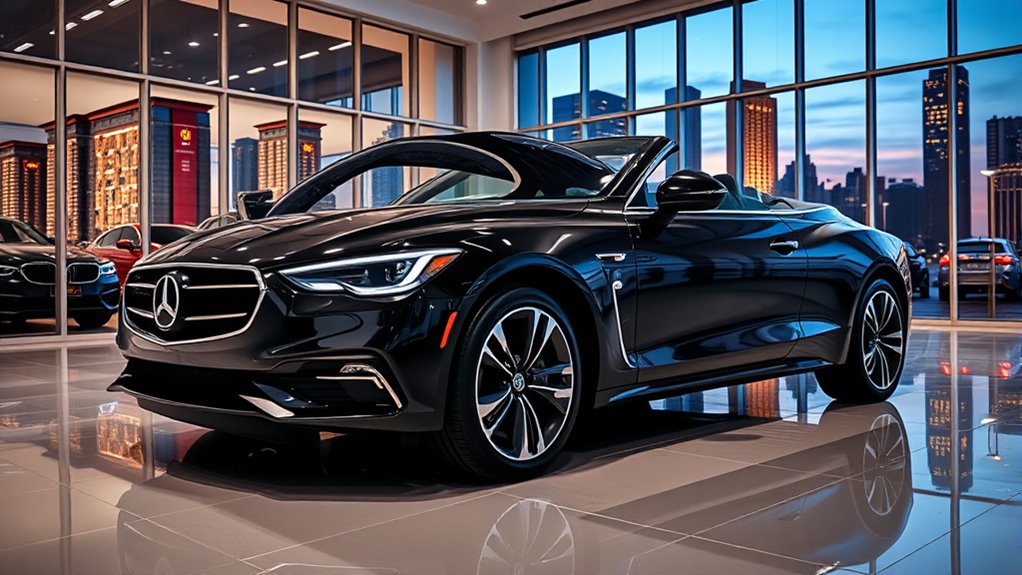Zero-down leases may seem like a great deal with no upfront costs and attractive incentives, but they can hide long-term expenses and risks. While you avoid initial payments, you might face high fees, excess mileage charges, or wear-and-tear penalties later. Plus, no equity is built in the vehicle, potentially costing you more over time. To uncover the full picture and decide if it’s worth it, keep exploring the details behind these deals.
Key Takeaways
- Zero-down leases eliminate upfront costs but often hide long-term expenses and fees.
- Lease incentives can reduce initial payments but may come with strings or eligibility restrictions.
- High residual values lower monthly payments but risk penalties if actual vehicle value drops.
- No initial investment means no equity, and potential extra costs can outweigh upfront savings.
- Careful evaluation of lease terms, residuals, and penalties is essential to avoid costly long-term outcomes.

Are zero-down leases a smart way to get a new vehicle without a hefty upfront payment? It’s tempting to think so, especially when lease incentives make the deal seem almost too good to pass up. With no initial out-of-pocket expense, you might imagine driving off the lot in a brand-new car without feeling the financial pinch. However, before jumping into a zero-down lease, it’s vital to understand how residual values and lease incentives work together and what hidden costs might lurk beneath the surface.
Lease incentives are designed to attract customers by reducing upfront costs or lowering monthly payments. Manufacturers often offer attractive lease deals, especially at the end of a model year, to boost sales and clear inventory. These incentives can include reduced or waived security deposits, lower money factors, or even cashback offers. While they seem appealing, they often come with strings attached. For example, the terms might favor the dealer more than the lessee, or you may only qualify for these incentives if you meet specific credit requirements. Still, they make zero-down leases look more accessible and less risky at first glance.
Lease incentives lower upfront costs but often come with strings attached, benefiting dealers more than lessees.
Residual values are another pivotal factor that influences the cost of your lease. Think of residual value as the estimate of what your car will be worth at the end of the lease term. A higher residual value typically means lower monthly payments because the car’s depreciation is less. When lease incentives are combined with a high residual, you might get a very attractive deal with no money down. But beware—if the residual value is set unrealistically high, you could be on the hook for excess mileage charges or wear-and-tear penalties if your vehicle’s worth drops significantly by the end of the lease.
While zero-down leasing can seem like a deal of the century, it’s essential to think about the long-term costs. You might save money upfront, but you could end up paying more over time in fees, penalties, or higher monthly payments if the residual value isn’t aligned with the car’s actual worth. Plus, since you’re not putting money down initially, you’re not building any equity in the vehicle. If you decide to buy the car at the end of the lease or lease again, those costs can add up quickly.
Frequently Asked Questions
Are Zero-Down Leases Suitable for Small Businesses?
You might consider zero-down leases if you’re seeking lease advantages that boost your business flexibility. These leases allow you to conserve cash upfront, making it easier to invest in other areas. However, be aware that while they offer short-term benefits, they could lead to higher monthly costs or penalties if you fail to meet terms. Assess your cash flow and long-term goals to decide if zero-down leases suit your small business needs.
What Are Hidden Costs in Zero-Down Lease Agreements?
Hidden costs in zero-down lease agreements are like hidden rocks beneath calm water—you might not see them until it’s too late. You could face unexpected charges during lease termination, such as early termination fees or penalties. Additionally, the residual value might be misrepresented, leading to higher costs if you decide to buy the equipment later. Always read the fine print to avoid these sneaky financial traps.
How Do Zero-Down Leases Compare to Traditional Financing?
When comparing zero-down leases to traditional financing, you’ll find that lease terms are often shorter and payments lower upfront, but interest rates can be higher over time. With leases, you avoid large initial costs, but you might face mileage limits and fees. Traditional financing typically involves higher initial payments and lower interest rates, giving you ownership. Your choice depends on whether you prioritize flexibility or long-term ownership.
Can Zero-Down Leases Be Negotiated for Better Terms?
You can often negotiate better terms on zero-down leases by discussing lease incentives and credit requirements with your provider. Highlight your strong credit history to potentially lower interest rates or reduce fees. Don’t hesitate to ask for added benefits like maintenance or upgrade options. Being proactive and informed helps you secure more favorable lease conditions, making the deal more aligned with your financial goals.
What Long-Term Financial Impacts Do Zero-Down Leases Have?
Imagine the future of your finances—zero-down leases often seem tempting, but they can cast shadows over your credit impact and lease term. You might enjoy short-term savings, but long-term, you could face higher payments and potential credit issues if you miss payments or lease terms lengthen. Carefully weigh whether the immediate benefits outweigh the possible financial traps, ensuring your decisions support your financial health.
Conclusion
Zero-down leases may seem like a golden ticket, a quick path to getting what you want without upfront costs. But remember, they can hide hidden fees, long-term burdens, and financial traps. So, weigh the promise against the pitfalls, the immediate against the future. Stay vigilant, stay informed, and don’t let the shiny deal blind you. Because in the end, a smart choice is the one that keeps your finances clear, your options open, and your peace of mind intact.










